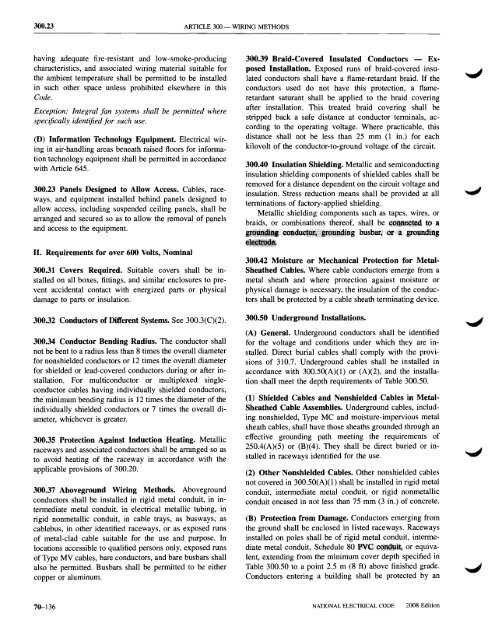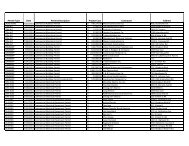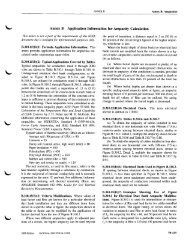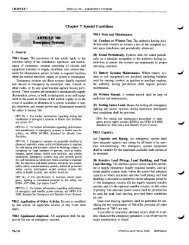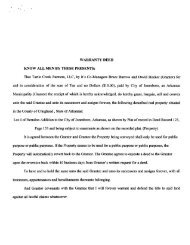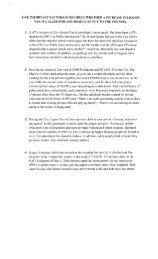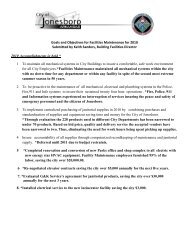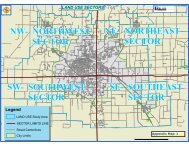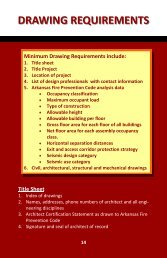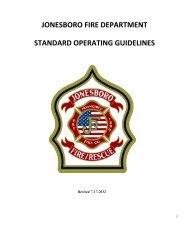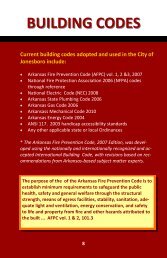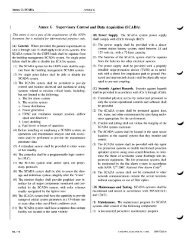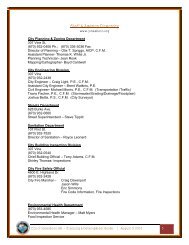Chapter 3 Wiring Methods and Materials
Chapter 3 Wiring Methods and Materials
Chapter 3 Wiring Methods and Materials
Create successful ePaper yourself
Turn your PDF publications into a flip-book with our unique Google optimized e-Paper software.
300.23 ARTICLE 300 - WIRING METHODS<br />
having adequate fire-resistant <strong>and</strong> low-smoke-producing<br />
characteristics, <strong>and</strong> associated wiring material suitable for<br />
the ambient temperature shall be permitted to be installed<br />
in such other space unless prohibited elsewhere in this<br />
Code.<br />
Exception: Integral fan systems shall be permitted where<br />
specifically identified for such use.<br />
(D) Information Technology Equipment. Electrical wiring<br />
in air-h<strong>and</strong>ling areas beneath raised floors for information<br />
technology equipment shall be permitted in accordance<br />
with Article 645.<br />
300.23 Panels Designed to Allow Access. Cables, raceways,<br />
<strong>and</strong> equipment installed behind panels designed to<br />
allow access, including suspended ceiling panels, shall be<br />
arranged <strong>and</strong> secured so as to allow the removal of panels<br />
<strong>and</strong> access to the equipment.<br />
II. Requirements for over 600 Volts, Nominal<br />
300.31 Covers Required. Suitable covers shall be installed<br />
on all boxes, fittings, <strong>and</strong> similar enclosures to prevent<br />
accidental contact with energized parts or physical<br />
damage to parts or insulation.<br />
300.32 Conductors of Different Systems. See 300.3(C)(2).<br />
300.34 Conductor Bending Radius. The conductor shall<br />
not be bent to a radius less than 8 times the overall diameter<br />
for nonshielded conductors or 12 times the overall diameter<br />
for shielded or lead-covered conductors during or after installation.<br />
For multiconductor or multiplexed singleconductor<br />
cables having individually shielded conductors,<br />
the minimum bending radius is 12 times the diameter of the<br />
individually shielded conductors or 7 times the overall diameter,<br />
whichever is greater.<br />
300.35 Protection Against Induction Heating. Metallic<br />
raceways <strong>and</strong> associated conductors shall be arranged so as<br />
to avoid heating of the raceway in accordance with the<br />
applicable provisions of 300.20.<br />
300.37 Aboveground <strong>Wiring</strong> <strong>Methods</strong>. Aboveground<br />
conductors shall be installed in rigid metal conduit, in intermediate<br />
metal conduit, in electrical metallic tubing, in<br />
rigid nonmetallic conduit, in cable trays, as busways, as<br />
cablebus, in other identified raceways, or as exposed runs<br />
of metal-clad cable suitable for the use <strong>and</strong> purpose. In<br />
locations accessible to qualified persons only, exposed runs<br />
of Type MV cables, bare conductors, <strong>and</strong> bare busbars shall<br />
also be permitted. Busbars shall be permitted to be either<br />
copper or aluminum.<br />
300.39 Braid-Covered Insulated Conductors - Exposed<br />
Installation. Exposed runs of braid-covered insulated<br />
conductors shall have a flame-retardant braid. If the<br />
conductors used do not have this protection, a flameretardant<br />
saturant shall be applied to the braid covering<br />
after installation. This treated braid covering shall be<br />
stripped back a safe distance at conductor terminals, according<br />
to the operating voltage. Where practicable, this<br />
distance shall not be less than 25 mm (l in.) for each<br />
kilovolt of the conductor-to-ground voltage of the circuit.<br />
300.40 Insulation Shielding. Metallic <strong>and</strong> semiconducting<br />
insulation shielding components of shielded cabks shall be<br />
removed for a distance dependent on the circuit voltage <strong>and</strong><br />
insulation. Stress reduction means shall be provided at all<br />
terminations of factory-applied shielding.<br />
Metallic shielding components such as tapes, wires, or<br />
braids, or combinations thereof, shall be loa<br />
busbati~/ij;.~aitlg<br />
300.42 Moisture or Mechanical Protection for Metal<br />
Sheathed Cables. Where cable conductors emerge from a<br />
metal sheath <strong>and</strong> where protection against moisture or<br />
physical damage is necessary, the insulation of the conductors<br />
shall be protected by a cable sheath terminating device.<br />
300.50 Underground Installations.<br />
(A) General. Underground conductors shall be identified<br />
for the voltage <strong>and</strong> conditions under which they are installed.<br />
Direct burial cables shall comply with the provisions<br />
of 310.7. Underground cables shall be installed in<br />
accordance with 300.50(A)(l) or (A)(2), <strong>and</strong> the installation<br />
shall meet the depth requirements of Table 300.50.<br />
(1) Shielded Cables <strong>and</strong> Nonshielded Cables lin Metal<br />
Sheathed Cable Assemblies. Underground cables, including<br />
nonshielded, Type MC <strong>and</strong> moisture-impervious metal<br />
sheath cables, shall have those sheaths grounded through an<br />
effective grounding path meeting the requirements of<br />
250.4(A)(5) or (B)(4). They shall be direct buried or installed<br />
in raceways identified for the use.<br />
(2) Other Nonshielded Cables. Other nonshieldled cables<br />
not covered in 300.50(A)(l) shall be installed in rigid metal<br />
conduit, intermediate metal conduit, or rigid nonmetallic<br />
conduit encased in not less than 75 mm (3 in.) of concrete.<br />
(B) Protection from Damage. Conductors emerging from<br />
the ground shall be enclosed in listed raceways. Raceways<br />
installed on poles shall be of rigid metal conduit, intermediate<br />
metal conduit, Schedule 80 P¥C/~' or equivalent,<br />
extending from the minimum cover depth specified in<br />
Table 300.50 to a point 2.5 m (8 ft) above finished grade.<br />
Conductors entering a building shall be protected by an<br />
70-136<br />
NATIONAL ELECTRICAL CODE<br />
2008 Edition


